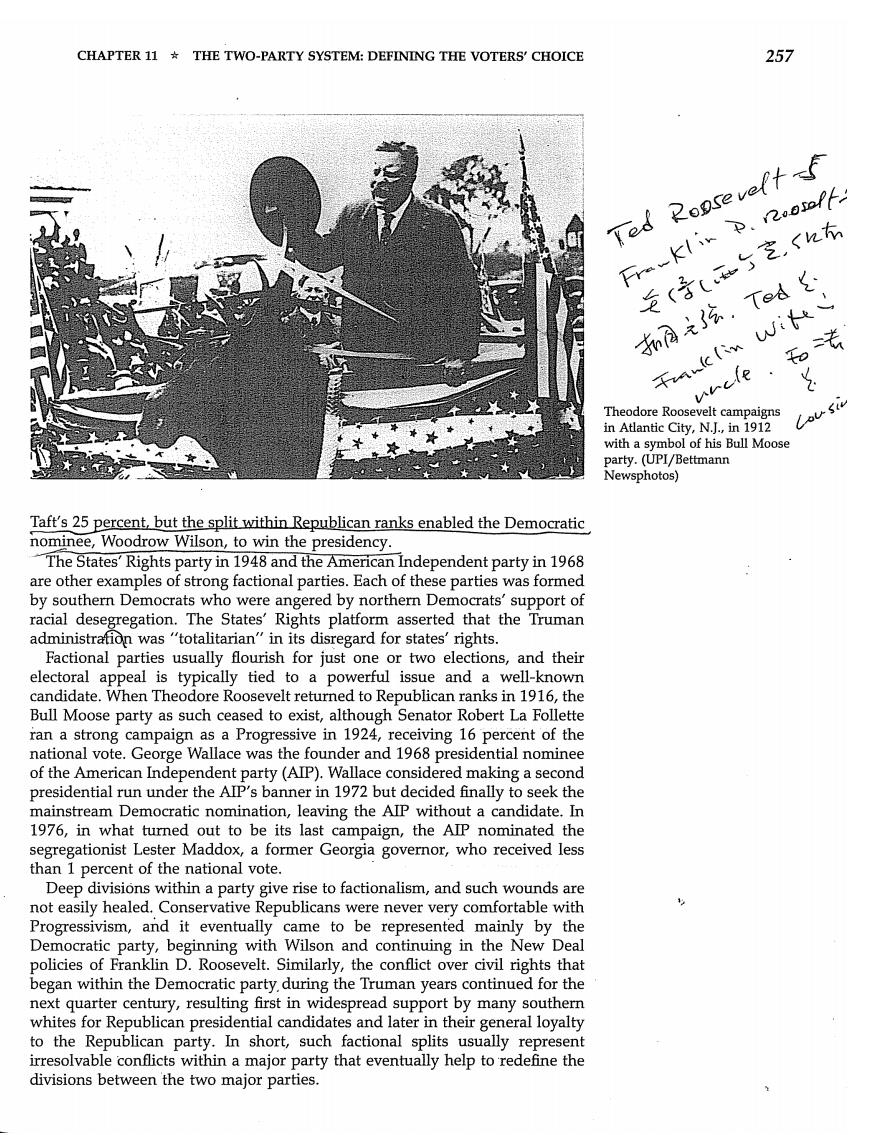
CHAPTER 11 THE TWO-PARTY SYSTEM:DEFINING THE VOTERS'CHOICE 257 Tod Rogsevelts Fr-klin rcook 专(子(之.2左 同会,Tcd足 wit 和浅 Theodore Roosevelt campaigns in Atlantic City,N.J.,in 1912 with a symbol of his Bull Moose party.(UPI/Bettmann Newsphotos) Taft's 25 percent,but the split within Republican ranks enabled the Democratic nominee,Woodrow Wilson,to win the presidency. The States'Rights party in 1948 and the American Independent party in 1968 are other examples of strong factional parties.Each of these parties was formed by southern Democrats who were angered by northern Democrats'support of racial desegregation.The States'Rights platform asserted that the Truman administrafion was"totalitarian"in its disregard for states'rights. Factional parties usually flourish for just one or two elections,and their electoral appeal is typically tied to a powerful issue and a well-known candidate.When Theodore Roosevelt returned to Republican ranks in 1916,the Bull Moose party as such ceased to exist,although Senator Robert La Follette ran a strong campaign as a Progressive in 1924,receiving 16 percent of the national vote.George Wallace was the founder and 1968 presidential nominee of the American Independent party(AIP).Wallace considered making a second presidential run under the AIP's banner in 1972 but decided finally to seek the mainstream Democratic nomination,leaving the AIP without a candidate.In 1976,in what turned out to be its last campaign,the AlP nominated the segregationist Lester Maddox,a former Georgia governor,who received less than 1 percent of the national vote. Deep divisions within a party give rise to factionalism,and such wounds are not easily healed.Conservative Republicans were never very comfortable with Progressivism,and it eventually came to be represented mainly by the Democratic party,beginning with Wilson and continuing in the New Deal policies of Franklin D.Roosevelt.Similarly,the conflict over civil rights that began within the Democratic party.during the Truman years continued for the next quarter century,resulting first in widespread support by many southern whites for Republican presidential candidates and later in their general loyalty to the Republican party.In short,such factional splits usually represent irresolvable conflicts within a major party that eventually help to redefine the divisions between the two major parties
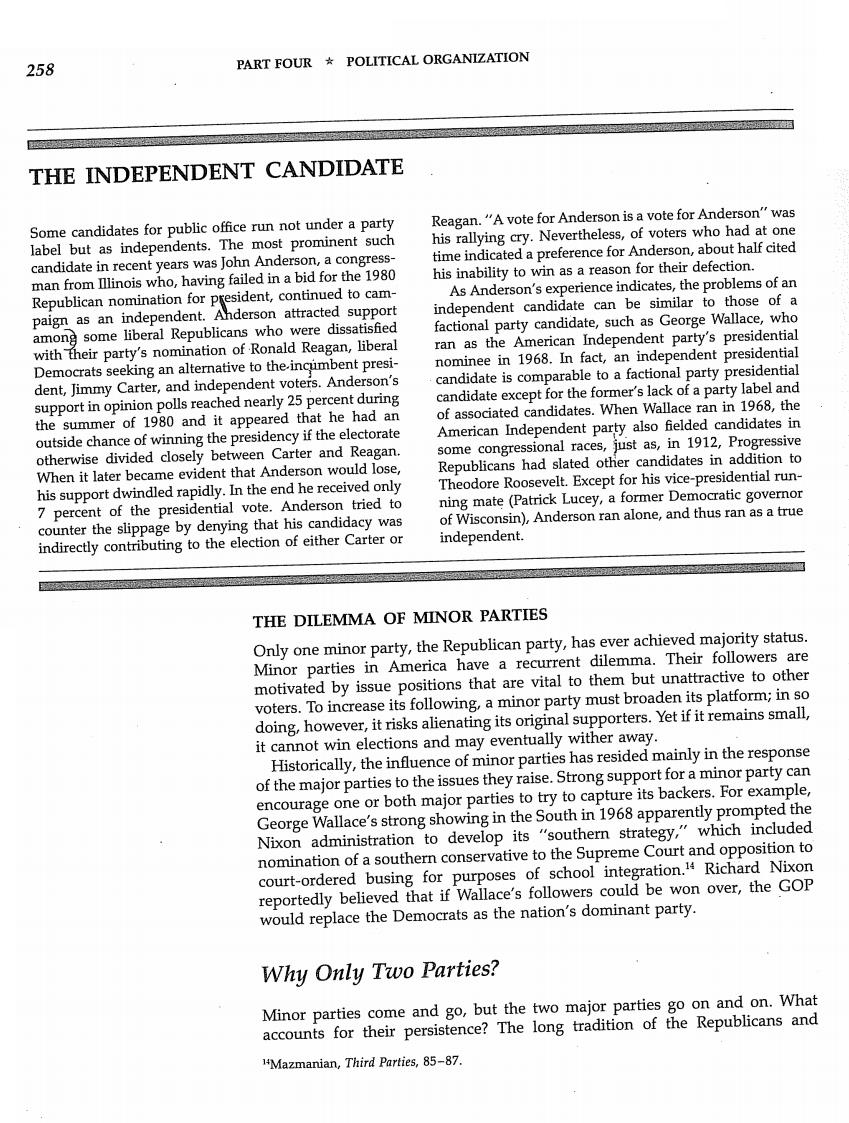
258 PART FOUR POLITICAL ORGANIZATION THE INDEPENDENT CANDIDATE Some candidates for public office run not under a party Reagan."A vote for Anderson is a vote for Anderson"was label but as independents.The most prominent such his rallying cry.Nevertheless,of voters who had at one candidate in recent years was John Anderson,a congress- time indicated a preference for Anderson,about half cited man from Illinois who,having failed in a bid for the 1980 his inability to win as a reason for their defection. Republican nomination for president,continued to cam- As Anderson's experience indicates,the problems of an paign as an independent.Ahderson attracted support independent candidate can be similar to those of a among some liberal Republicans who were dissatisfied factional party candidate,such as George Wallace,who with their party's nomination of Ronald Reagan,liberal ran as the American Independent party's presidential Democrats seeking an alternative to the-incumbent presi- nominee in 1968.In fact,an independent presidential dent,Jimmy Carter,and independent voters.Anderson's candidate is comparable to a factional party presidential support in opinion polls reached nearly 25 percent during candidate except for the former's lack of a party label and the summer of 1980 and it appeared that he had an of associated candidates.When Wallace ran in 1968,the outside chance of winning the presidency if the electorate American Independent party also fielded candidates in otherwise divided closely between Carter and Reagan. some congressional races,just as,in 1912,Progressive When it later became evident that Anderson would lose, Republicans had slated other candidates in addition to his support dwindled rapidly.In the end he received only Theodore Roosevelt.Except for his vice-presidential run- 7 percent of the presidential vote.Anderson tried to ning mate(Patrick Lucey,a former Democratic governor counter the slippage by denying that his candidacy was of Wisconsin),Anderson ran alone,and thus ran as a true indirectly contributing to the election of either Carter or independent. THE DILEMMA OF MINOR PARTIES Only one minor party,the Republican party,has ever achieved majority status. Minor parties in America have a recurrent dilemma.Their followers are motivated by issue positions that are vital to them but unattractive to other voters.To increase its following,a minor party must broaden its platform;in so doing,however,it risks alienating its original supporters.Yet if it remains small, it cannot win elections and may eventually wither away. Historically,the influence of minor parties has resided mainly in the response of the major parties to the issues they raise.Strong support for a minor party can encourage one or both major parties to try to capture its backers.For example, George Wallace's strong showing in the South in 1968 apparently prompted the Nixon administration to develop its "southern strategy,"which included nomination of a southern conservative to the Supreme Court and opposition to court-ordered busing for purposes of school integration.14 Richard Nixon reportedly believed that if Wallace's followers could be won over,the GOP would replace the Democrats as the nation's dominant party. Why Only Two Parties? Minor parties come and go,but the two major parties go on and on.What accounts for their persistence?The long tradition of the Republicans and Mazmanian,Third Parties,85-87
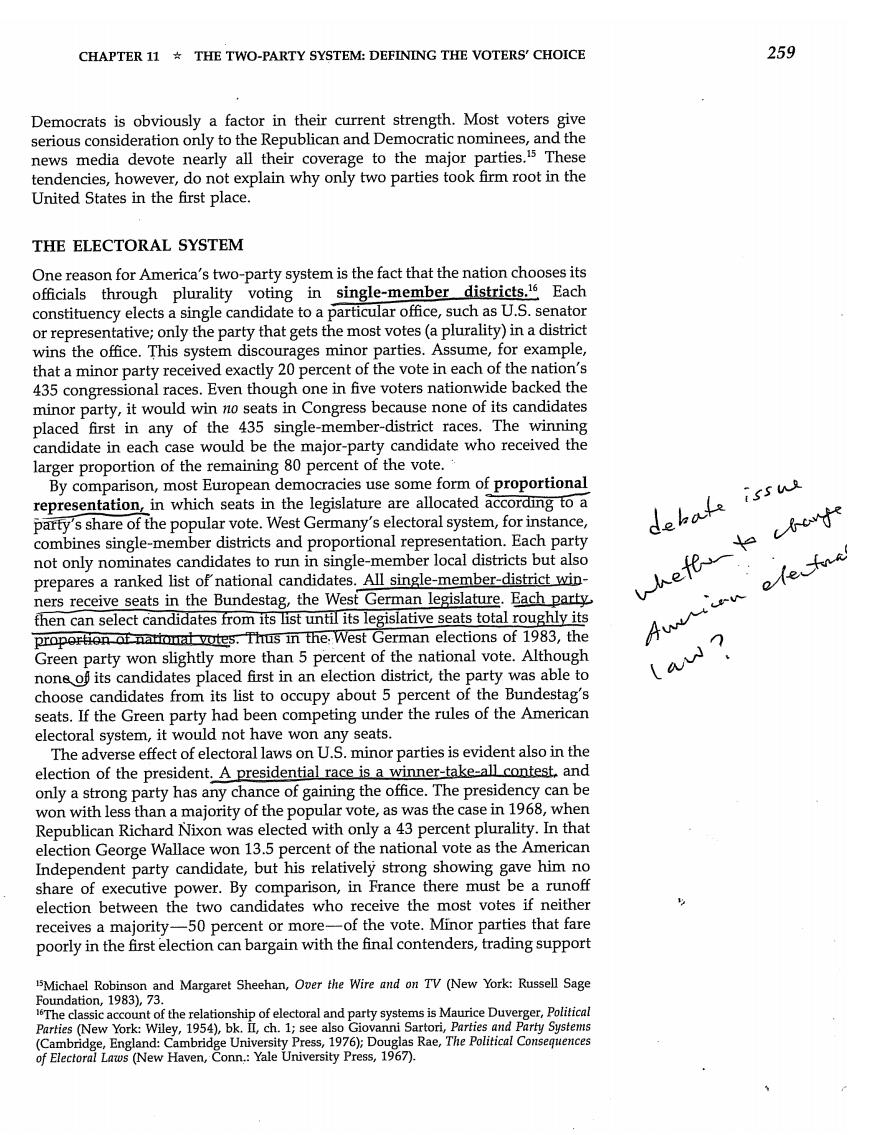
CHAPTER 11 THE TWO-PARTY SYSTEM:DEFINING THE VOTERS'CHOICE 259 Democrats is obviously a factor in their current strength.Most voters give serious consideration only to the Republican and Democratic nominees,and the news media devote nearly all their coverage to the major parties.15 These tendencies,however,do not explain why only two parties took firm root in the United States in the first place. THE ELECTORAL SYSTEM One reason for America's two-party system is the fact that the nation chooses its officials through plurality voting in single-member districts.16 Each constituency elects a single candidate to a particular office,such as U.S.senator or representative;only the party that gets the most votes(a plurality)in a district wins the office.This system discourages minor parties.Assume,for example, that a minor party received exactly 20 percent of the vote in each of the nation's 435 congressional races.Even though one in five voters nationwide backed the minor party,it would win no seats in Congress because none of its candidates placed first in any of the 435 single-member-district races.The winning candidate in each case would be the major-party candidate who received the larger proportion of the remaining 80 percent of the vote. By comparison,most European democracies use some form of proportional representation,in which seats in the legislature are allocated according to a issu party's share of the popular vote.West Germany's electoral system,for instance, debat combines single-member districts and proportional representation.Each party not only nominates candidates to run in single-member local districts but also prepares a ranked list of national candidates.All single-member-district wip- 人efe ners receive seats in the Bundestag,the West German legislature.Each party then can select candidates from its list until its legislative seats total roughly its proportion of national vyotes.Thus in the.West German elections of 1983,the Green party won slightly more than 5 percent of the national vote.Although none of its candidates placed first in an election district,the party was able to (W? choose candidates from its list to occupy about 5 percent of the Bundestag's seats.If the Green party had been competing under the rules of the American electoral system,it would not have won any seats. The adverse effect of electoral laws on U.S.minor parties is evident also in the election of the president.A presidential race is a winner-take-all contest,and only a strong party has any chance of gaining the office.The presidency can be won with less than a majority of the popular vote,as was the case in 1968,when Republican Richard Nixon was elected with only a 43 percent plurality.In that election George Wallace won 13.5 percent of the national vote as the American Independent party candidate,but his relatively strong showing gave him no share of executive power.By comparison,in France there must be a runoff election between the two candidates who receive the most votes if neither receives a majority-50 percent or more-of the vote.Minor parties that fare poorly in the first election can bargain with the final contenders,trading support i5Michael Robinson and Margaret Sheehan,Over the Wire and on TV(New York:Russell Sage Foundation,1983),73. The classic account of the relationship of electoral and party systems is Maurice Duverger,Political Parties (New York:Wiley,1954),bk.II,ch.1;see also Giovanni Sartori,Parties and Party Systems (Cambridge,England:Cambridge University Press,1976);Douglas Rae,The Political Consequences of Electoral Laws (New Haven,Conn,:Yale University Press,1967)
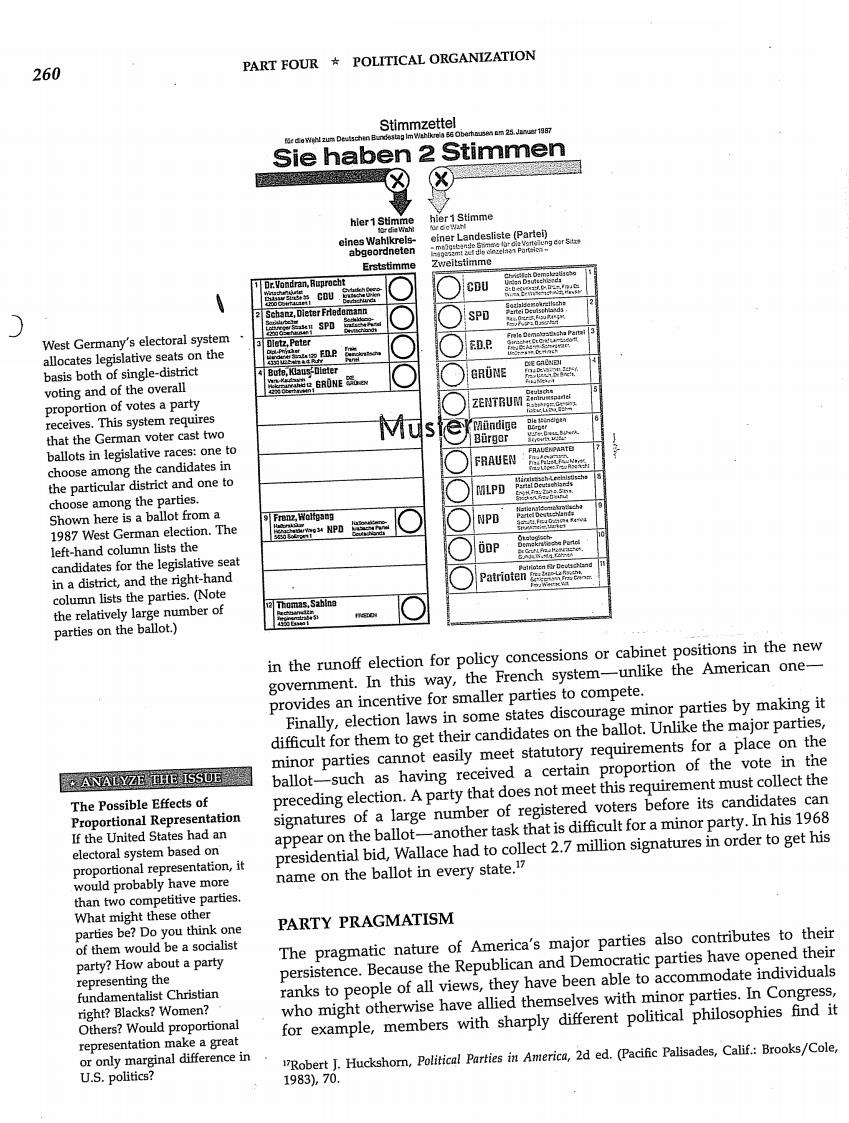
260 PART FOUR POLITICAL ORGANIZATION Stimmzettel ahau5gm25,地19 Sie haben 2 Stimmen hler 1 Stimme ewiah cines Wahlkrels- oiner Landesliste (Partei) abgeordneten Erststimme Zweitstimme Dr.Vondran,Ruprocht CDU 品 SPD SPD ssha Peltai West Germany's electoral system Dletz,Peter ED.P allocates legislative seats on the basis both of single-district Bute,Klaus-Dieter GRUNE voting and of the overall proportion of votes a party ZENTRUM receives.This system requires Mundige that the German voter cast two Mus Burgor ballots in legislative races:one to FRALENPARTB choose among the candidates in FRAUEN the particular district and one to MALPD choose among the parties. ch? Shown here is a ballot from a NPD 1987 West German election.The NPD left-hand column lists the candidates for the legislative seat in a district,and the right-hand Patrioten column lists the parties.(Note the relatively large number of Thomas,Sahine parties on the ballot.) in the runoff election for policy concessions or cabinet positions in the new government.In this way,the French system-unlike the American one- provides an incentive for smaller parties to compete. Finally,election laws in some states discourage minor parties by making it difficult for them to get their candidates on the ballot.Unlike the major parties, minor parties cannot easily meet statutory requirements for a place on the 女ANALYZ正E1ISS0正 ballot-such as having received a certain proportion of the vote in the The Possible Effects of preceding election.A party that does not meet this requirement must collect the Proportional Representation signatures of a large number of registered voters before its candidates can If the United States had an appear on the ballot-another task that is difficult for a minor party.In his 1968 electoral system based on presidential bid,Wallace had to collect 2.7 million signatures in order to get his proportional representation,it would probably have more name on the ballot in every state.17 than two competitive parties. What might these other parties be?Do you think one PARTY PRAGMATISM of them would be a socialist The pragmatic nature of America's major parties also contributes to their party?How about a party persistence.Because the Republican and Democratic parties have opened their representing the fundamentalist Christian ranks to people of all views,they have been able to accommodate individuals right?Blacks?Women? who might otherwise have allied themselves with minor parties.In Congress, Others?Would proportional for example,members with sharply different political philosophies find it representation make a great or only marginal difference in Robert J.Huckshorn,Political Parties in America,2d ed.(Pacific Palisades,Calif.:Brooks/Cole, U.S.politics? 1983),70
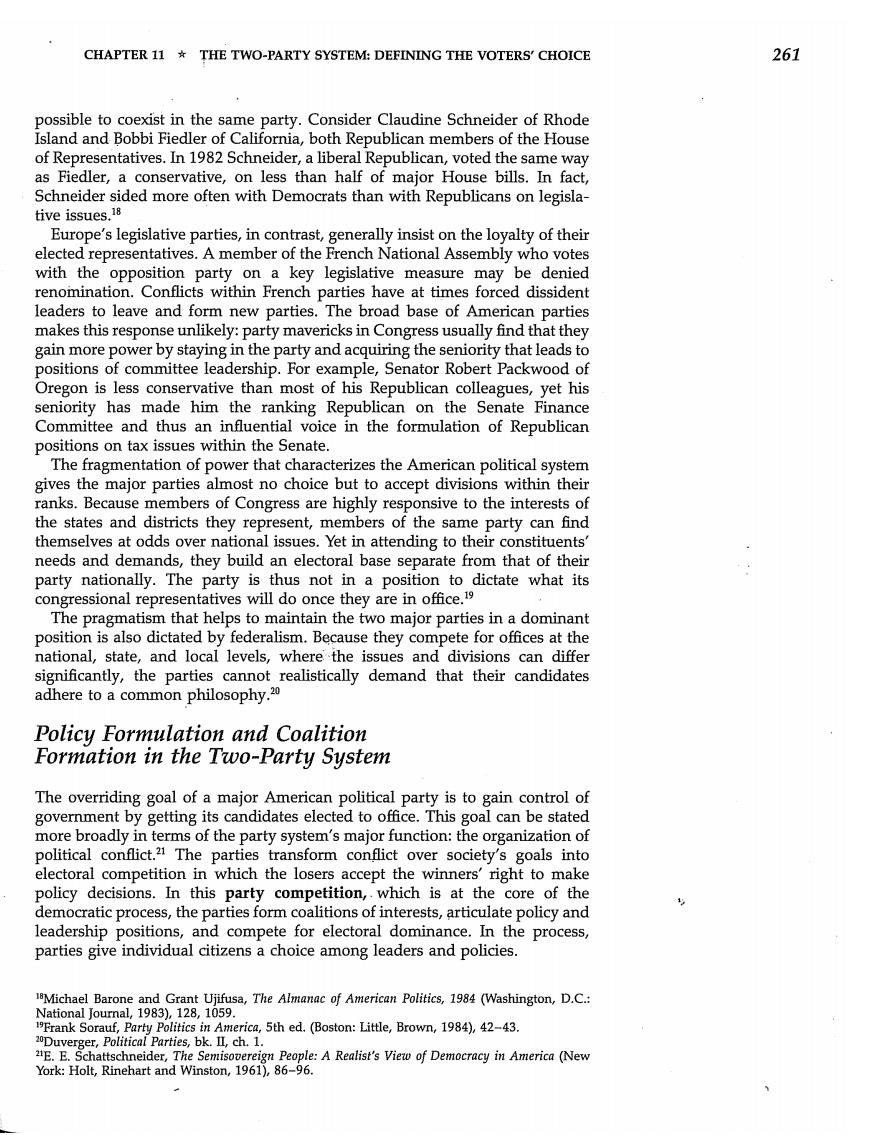
CHAPTER 11 THE TWO-PARTY SYSTEM:DEFINING THE VOTERS'CHOICE 261 possible to coexist in the same party.Consider Claudine Schneider of Rhode Island and Bobbi Fiedler of California,both Republican members of the House of Representatives.In 1982 Schneider,a liberal Republican,voted the same way as Fiedler,a conservative,on less than half of major House bills.In fact, Schneider sided more often with Democrats than with Republicans on legisla- tive issues.18 Europe's legislative parties,in contrast,generally insist on the loyalty of their elected representatives.A member of the French National Assembly who votes with the opposition party on a key legislative measure may be denied renomination.Conflicts within French parties have at times forced dissident leaders to leave and form new parties.The broad base of American parties makes this response unlikely:party mavericks in Congress usually find that they gain more power by staying in the party and acquiring the seniority that leads to positions of committee leadership.For example,Senator Robert Packwood of Oregon is less conservative than most of his Republican colleagues,yet his seniority has made him the ranking Republican on the Senate Finance Committee and thus an influential voice in the formulation of Republican positions on tax issues within the Senate. The fragmentation of power that characterizes the American political system gives the major parties almost no choice but to accept divisions within their ranks.Because members of Congress are highly responsive to the interests of the states and districts they represent,members of the same party can find themselves at odds over national issues.Yet in attending to their constituents' needs and demands,they build an electoral base separate from that of their party nationally.The party is thus not in a position to dictate what its congressional representatives will do once they are in office.19 The pragmatism that helps to maintain the two major parties in a dominant position is also dictated by federalism.Because they compete for offices at the national,state,and local levels,where the issues and divisions can differ significantly,the parties cannot realistically demand that their candidates adhere to a common philosophy.20 Policy Formulation and Coalition Formation in the Two-Party System The overriding goal of a major American political party is to gain control of government by getting its candidates elected to office.This goal can be stated more broadly in terms of the party system's major function:the organization of political conflict.21 The parties transform conflict over society's goals into electoral competition in which the losers accept the winners'right to make policy decisions.In this party competition,.which is at the core of the democratic process,the parties form coalitions of interests,articulate policy and leadership positions,and compete for electoral dominance.In the process, parties give individual citizens a choice among leaders and policies. Michael Barone and Grant Ujifusa,The Almanac of American Politics,1984 (Washington,D.C.: National Journal,1983),128,1059. 1Frank Sorauf,Party Politics in America,5th ed.(Boston:Little,Brown,1984),42-43. 2Duverger,Political Parties,bk.II,ch.1. E.E.Schattschneider,The Semisovereign People:A Realist's View of Democracy in America (New York:Holt,Rinehart and Winston,1961),86-96